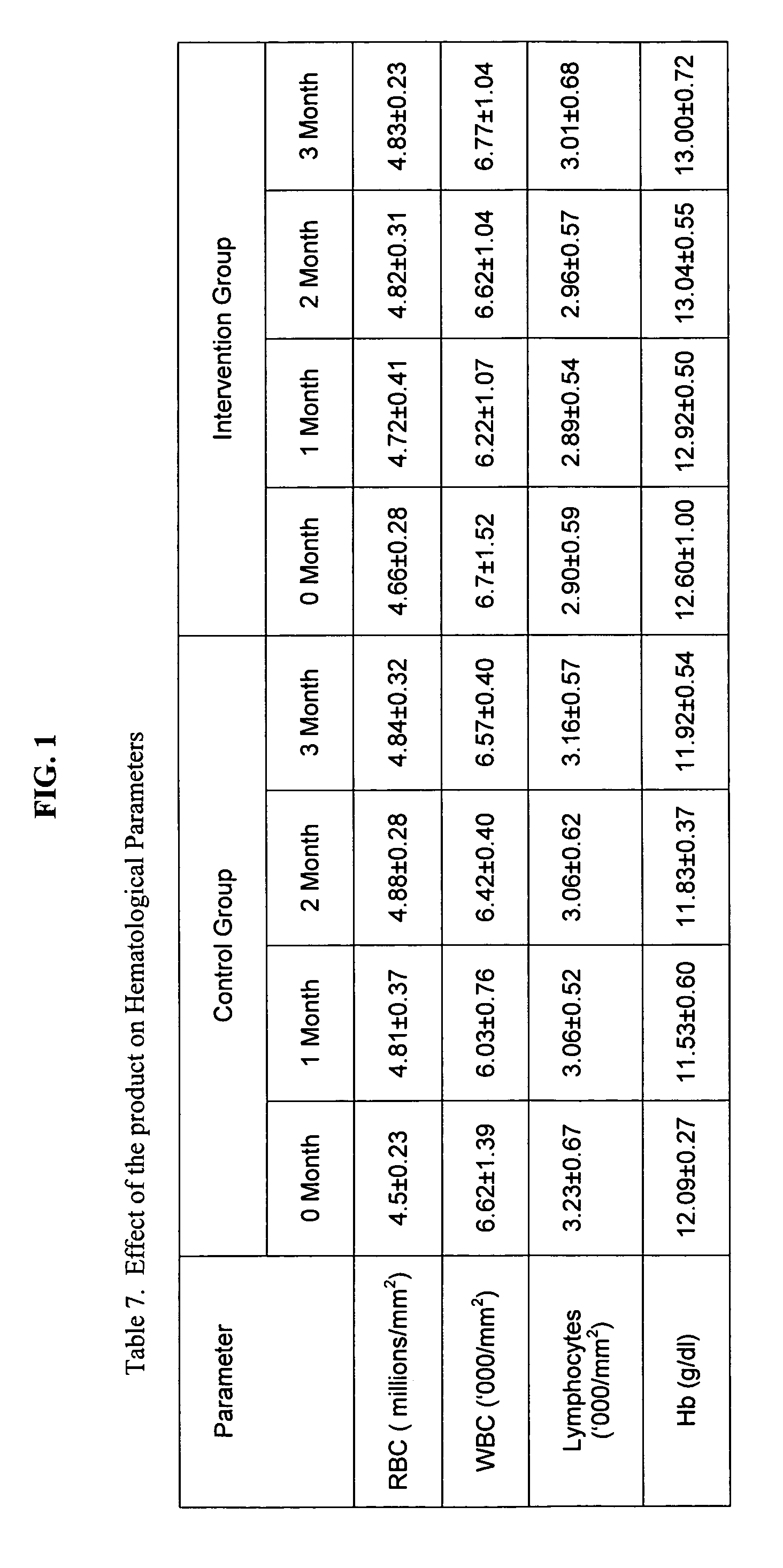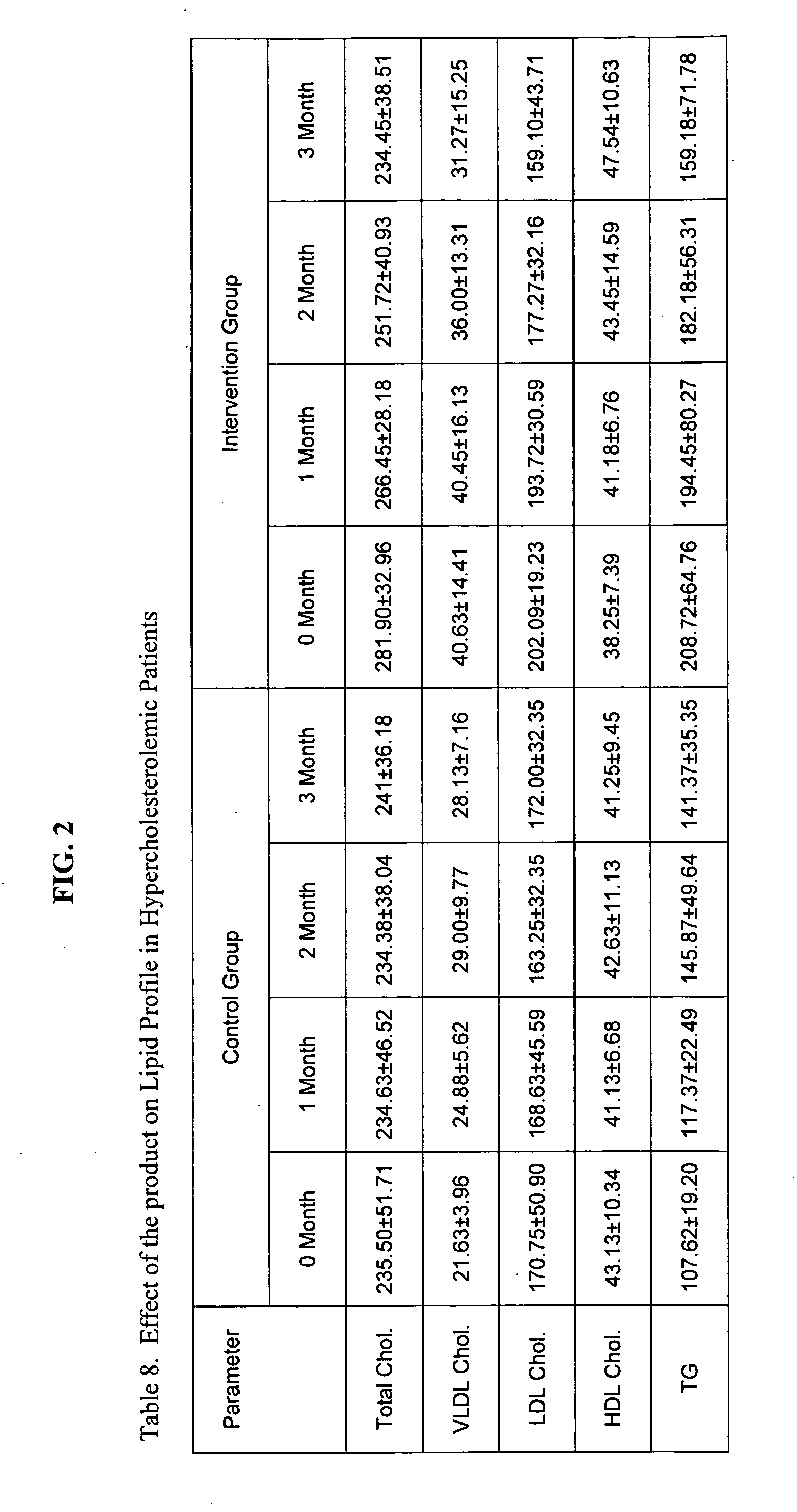Composition to enhance HDL cholesterol and to decrease intima-media thickening in animals and humans and a method for its preparation
a technology of enhancing hdl cholesterol and reducing intima-media thickening, which is applied in the field of composition to enhance hdl cholesterol and reduce intima-media thickening in animals and humans, and a method for its preparation, can solve the problems of short-term increase in hdl cholesterol, biliary cholesterol and fecal cholesterol loss, and reduce the risk of cardiovascular disease, so as to enhance desirable hdl cholesterol and reduce harmful l
- Summary
- Abstract
- Description
- Claims
- Application Information
AI Technical Summary
Benefits of technology
Problems solved by technology
Method used
Image
Examples
example 1
[0100] Five hundred kilograms of fresh amla fruits were pulped with an equal quantity of demineralized water and the slurry was treated with 2 wt % of pectinase enzyme under stirring at room temperature for 6 h and then filtered to yield 310 litres of the extract with a solids content of 4.8%. This solution was then concentrated below 60° C. to obtain a slurry with a solids content of 15.2%. This was then spray-dried (inlet temperature 180° C., outlet temperature 90° C.) to obtain 13.5 kg of a free flowing powder. The hydrolysable tannin content of this preparation was at least 30%. The emblicanin A content of this preparation was 10.2%.
example 2
Toxicity Studies
Acute Toxicity
[0101] Healthy albino mice of either sex, having body weight 20-25 g were used. They were housed in clean polypropylene cages with food and water available ad libitum. After acclimatization for one week, their body weights were recorded and were divided into 8 groups of 6 each. Group A served as control and the remaining 7 groups were kept as experimental group. The experimental animals were supplied 200 mg, 400 mg, 600 mg, 800 mg, 2.5 g, 5 g and 10 g / kg of amla extract, respectively, orally after an overnight fasting. Animals were observed continuously for the first 6 h and mortality was recorded for 72 hours.
[0102] Amla extract up to a dosage level of 10 g / kg body weight produced no adverse effects such as increased motor activity, tremors, clonic convulsions, piloerection, muscle spasm, hyperesthesia, ataxia, sedation, hypnosis and analgesia. No mortality was recorded in 72 hours.
Sub Acute Toxicity
[0103] Thirty healthy male Sprague-Dawly rats ...
example 3
[0113] Male NZ white rabbits weighing 1.3-1.6 kg were individually caged and fed a normal standard diet. After an acclimatization period, they were divided into 4 groups of 5 animals each. One group (Group A) served as control and groups B1, B2 and B3 served as experimental groups. The experimental groups were made hypercholesterolemic by feeding 100 mg cholesterol along with the diet daily for 4 months. After 4 months, Group B1 was kept as untreated hypercholesterolemic control and the remaining two groups (B2 and B3) were fed orally with amla extract in the dosage of 10 mg and 20 mg / kg / day, respectively, for additional 4 months. Body weights of animals were recorded every 15 days.
[0114] Before starting the experiment, fasting blood was collected from all animals for estimation of serum total cholesterol, LDL cholesterol (LDL-C), HDL cholesterol (HDL-C) and triglycerides (TG). Blood samples were also analyzed for haematological parameters (RBC, WBC, haemoglobin (Hb) and lymphocyte...
PUM
 Login to View More
Login to View More Abstract
Description
Claims
Application Information
 Login to View More
Login to View More - R&D
- Intellectual Property
- Life Sciences
- Materials
- Tech Scout
- Unparalleled Data Quality
- Higher Quality Content
- 60% Fewer Hallucinations
Browse by: Latest US Patents, China's latest patents, Technical Efficacy Thesaurus, Application Domain, Technology Topic, Popular Technical Reports.
© 2025 PatSnap. All rights reserved.Legal|Privacy policy|Modern Slavery Act Transparency Statement|Sitemap|About US| Contact US: help@patsnap.com


